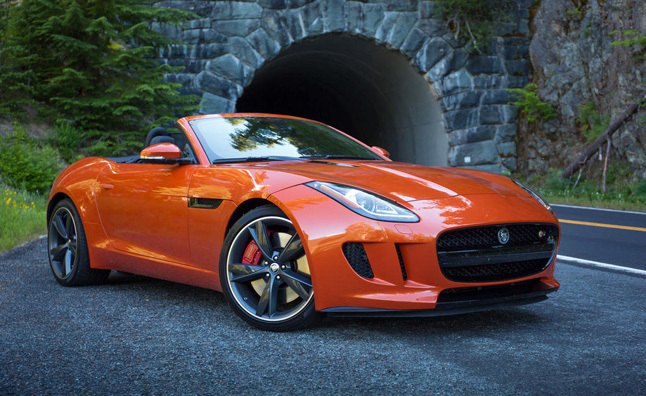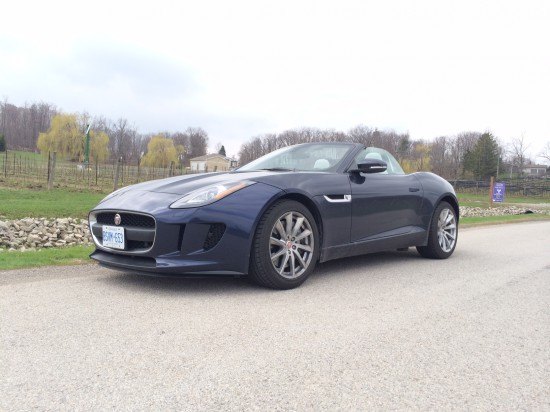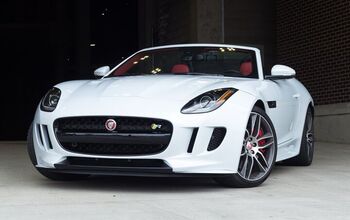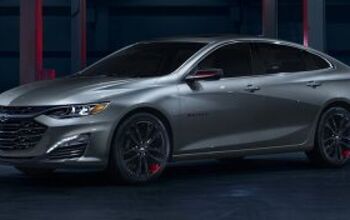Capsule Review: Jaguar F-Type – Base Is Best
How much power is enough? 300 horsepower? 400? 500? Let’s put it another way? How much is enough to impress people you don’t even like?
The vehicle above is identical to the Jaguar F-Type V8S I drove: Sandfire Metallic, Dynamic Mode, cheesy gold-painted plastic paddles (ugh) and an exhaust note that sounds like a 1200cc Harley with the mufflers cut off – with some added popping-and-farting noises programmed in for good measure.
This is a car that impresses other people. It looks like a sports car, or even a junior exotic. It certainly sounds like one. As I recounted in my last review of the F-Type V6S, it is one automobile that really does make you more attractive to the opposite sex. It’s also the worst F-Type variant on the market.
Ok, the soundtrack is intoxicating – to a point. The only way you can enjoy that mechanical orchestra is to accelerate really quickly and then let off the gas, to decelerate to the point where you might get a hefty speeding ticket, but not a roadside impound. Forget flying under the radar (literally) – it’s so bloody loud that every highway patrolman or concerned citizen within a 25 mile radius can hear what you’re doing. The Group B rally-car noises plumbed in to the V8 exhaust note is like spiking Chateauneuf-du-Pape with Grape Kool-Aid.
While you’re doing busy making a scene, you are probably negotiating some bends, and the V8S, with its extra two-cylinders, supercharger and associated plumbing and massive wheels, feels substantially heavier than the other models. The difference coming out of the two cars is drastic, like you’ve just removed a rucksack full of dumbbells from its back…err, front.
The best comparison that can be made is between the various last-gen Mustangs. As you go from a Shelby GT500 to a V8 to a V6, you feel the nose get lighter and lighter progressively. Which shouldn’t matter on a less track-focused car that’s all about excitement and getting attention to make up for a lack of parental love. But it does, especially when you’re getting an indicated 11 mpg, while trying to use the F-Type’s quad pipes to recreate the sounds of the Battle of Britain.
When it was time to return the V8S, I felt satisfied that I had been sufficiently validated by anonymous motorists and pedestrians. It was time for the V6S – or so I thought. Horror of horrors, it turned out that I was incorrect. It was a V6. The base V6. Oh, the indignity of having to drive a base model F-Type, with just 340 horsepower (rather than the 380 ponies of the V6S), a (slightly) quieter exhaust, and smaller wheels without faux-Brembo red calipers.
Well, it turned out to be a thoroughly enjoyable experience. As good as the V6S I raved about last fall? No. But there would be no shame in driving one of these every day, because if nothing else, it’s more exciting than a base Boxster. For starters, the aforementioned front-end liposuction works wonders in everyday situations. The base F-Type actually feels nimble and easy to toss around, to say nothing of maneuvering through traffic. There’s still Dynamic Mode, the active exhaust and a Sport Mode for the transmission, which makes things a fair bit louder and a bit more raw, without sacrificing everyday comfort or drawing the ire of your neighbors when coming home late at night.
Despite being down 40 horsepower compared to the V6S, the base car is still reasonably quick, but adds another level of engagement to the experience. You have to work the car a bit harder to access the still-plentiful power reserves, and in the real word, that’s often more rewarding – meanwhile, fuel economy was an observed 23 mpg, or about double what I recorded during the V8S’ totally unscientific acceleration/efficiency testing. At a base price of $69,000, it’s also about $23,000 less than the V8S.
Ask yourself, can you live with an extra $23,000, while also having to tell people that yes, the V6 models are actually the superior choice? I tried, and my explanations about less weight over the nose, a more exotic soundtrack (the V8 sounds like a cross between a Spitfire aircraft and a Pontiac GTO – the V6 sounds like a cross between a Lancia Stratos and Hendrix’s version of Voodoo Chile ) and, worst of all, less horsepower.
Personally, I gave up, exasperated, but I didn’t care. A lot of people do. They have to be able to tell people that they bought the best, the most powerful, the most expensive, even if its capabilities are so beyond them, it would be like giving a .500 S&W Magnum to somebody who doesn’t know how to fire a .38. It’s all that most F-Type buyers really need, but when does logic ever pop into the sports car purchase decision?
I know this because I’m the kind of person that felt exactly the same way about the V6 Mustang – it’s more nimble and agile, it’s got plenty of power and it’s the better choice for most daily driving situations. But I’m vain, and I’d never buy a V6 Mustang because then, you won’t be impressing strangers and people you don’t actually like. But I’m human, and prone to inconsistencies bordering on the hypocritical. And with the F-Type, I’m making a deviation from my usual logic.
I wish I could close out the article by saying that my girlfriend agrees that the V6 is her choice too, but she just dumped me. All I can think about is how even though the Porsche Boxster is a sharper machine, I’d really like to go for a drive in the F-Type right now. Given the chance, I would take the V6, not the V8, to help me clear my head and get over the fact that my passenger seat is going to be empty for the next little while.
More by Derek Kreindler
Latest Car Reviews
Read moreLatest Product Reviews
Read moreRecent Comments
- Stan Reither Jr. Part throttle efficiency was mentioned earlier in a postThis type of reciprocating engine opens the door to achieve(slightly) variable stroke which would provide variable mechanical compression ratio adjustments for high vacuum (light load) or boost(power) conditions IMO
- Joe65688619 Keep in mind some of these suppliers are not just supplying parts, but assembled components (easy example is transmissions). But there are far more, and the more they are electronically connected and integrated with rest of the platform the more complex to design, engineer, and manufacture. Most contract manufacturers don't make a lot of money in the design and engineering space because their customers to that. Commodity components can be sourced anywhere, but there are only a handful of contract manufacturers (usually diversified companies that build all kinds of stuff for other brands) can engineer and build the more complex components, especially with electronics. Every single new car I've purchased in the last few years has had some sort of electronic component issue: Infinti (battery drain caused by software bug and poorly grounded wires), Acura (radio hiss, pops, burps, dash and infotainment screens occasionally throw errors and the ignition must be killed to reboot them, voice nav, whether using the car's system or CarPlay can't seem to make up its mind as to which speakers to use and how loud, even using the same app on the same trip - I almost jumped in my seat once), GMC drivetrain EMF causing a whine in the speakers that even when "off" that phased with engine RPM), Nissan (didn't have issues until 120K miles, but occassionally blew fuses for interior components - likely not a manufacturing defect other than a short developed somewhere, but on a high-mileage car that was mechanically sound was too expensive to fix (a lot of trial and error and tracing connections = labor costs). What I suspect will happen is that only the largest commodity suppliers that can really leverage their supply chain will remain, and for the more complex components (think bumper assemblies or the electronics for them supporting all kinds of sensors) will likley consolidate to a handful of manufacturers who may eventually specialize in what they produce. This is part of the reason why seemingly minor crashes cost so much - an auto brand does nst have the parts on hand to replace an integrated sensor , nor the expertice as they never built them, but bought them). And their suppliers, in attempt to cut costs, build them in way that is cheap to manufacture (not necessarily poorly bulit) but difficult to replace without swapping entire assemblies or units).I've love to see an article on repair costs and how those are impacting insurance rates. You almost need gap insurance now because of how quickly cars depreciate yet remain expensive to fix (orders more to originally build, in some cases). No way I would buy a CyberTruck - don't want one, but if I did, this would stop me. And it's not just EVs.
- Joe65688619 I agree there should be more sedans, but recognize the trend. There's still a market for performance oriented-drivers. IMHO a low budget sedan will always be outsold by a low budget SUV. But a sports sedan, or a well executed mid-level sedan (the Accord and Camry) work. Smaller market for large sedans except I think for an older population. What I'm hoping to see is some consolidation across brands - the TLX for example is not selling well, but if it was offered only in the up-level configurations it would not be competing with it's Honda sibling. I know that makes the market smaller and niche, but that was the original purpose of the "luxury" brands - badge-engineering an existing platform at a relatively lower cost than a different car and sell it with a higher margin for buyers willing and able to pay for them. Also creates some "brand cachet." But smart buyers know that simple badging and slightly better interiors are usually not worth the cost. Put the innovative tech in the higher-end brands first, differentiate they drivetrain so it's "better" (the RDX sells well for Acura, same motor and tranmission, added turbo which makes a notable difference compared to the CRV). The sedan in many Western European countries is the "family car" as opposed to micro and compact crossovers (which still sell big, but can usually seat no more than a compact sedan).
- Jonathan IMO the hatchback sedans like the Audi A5 Sportback, the Kia Stinger, and the already gone Buick Sportback are the answer to SUVs. The A5 and the AWD version of the Stinger being the better overall option IMO. I drive the A5, and love the depth and size of the trunk space as well as the low lift over. I've yet to find anything I need to carry that I can't, although I admit I don't carry things like drywall, building materials, etc. However, add in the fun to drive handling characteristics, there's almost no SUV that compares.
- C-b65792653 I'm starting to wonder about Elon....again!!I see a parallel with Henry Ford who was the wealthiest industrialist at one time. Henry went off on a tangent with the peace ship for WWI, Ford TriMotor, invasive social engineering, etc. Once the economy went bad, the focus fell back to cars. Elon became one of the wealthiest industrialist in the 21st century. Then he went off with the space venture, boring holes in the ground venture, "X" (formerly Twitter), etc, etc, etc. Once Tesla hit a plateau and he realized his EVs were a commodity, he too is focused on his primary money making machine. Yet, I feel Elon is over reacting. Down sizing is the nature of the beast in the auto industry; you can't get around that. But hacking the Super Charger division is like cutting off your own leg. IIRC, GM and Ford were scheduled to sign on to the exclusive Tesla charging format. That would have doubled or tripled his charging opportunity. I wonder what those at the Renaissance Center and the Glass House are thinking now. As alluded to, there's blood in the water and other charging companies will fill the void. I believe other nations have standardized EV charging (EU & China). Elon had the chance to have his charging system as the default in North America. Now, he's dropped the ball. He's lost considerable influence on what the standardized format will eventually be. Tremendous opportunity lost. 🚗🚗🚗

































![2016 Jaguar F-Type S Review - Row Your Own Kitty [w/ Video]](https://cdn-fastly.thetruthaboutcars.com/media/2022/07/19/9242323/2016-jaguar-f-type-s-review-row-your-own-kitty-w-video.jpg?size=350x220)











Comments
Join the conversation
The V8 does sound raucous, but I do prefer the sound of the V6. Most cylinder counts have their "best X cylinder sound" representatives, but after a while, to me, the new era of high strung cross-plane crank V8s sound too manufactured, too raspy. The lub-lub-lub sound of bigger bore less stressed V8s with deep full tones in that traditional American style is just some of the best stuff. Kudos to Mercedes and their '55' and 6.3' AMG V8s...and to Audi's R and S line 4.2s for achieving such vicious/murderous sounding 8s, too...which I understand undermines my previous statement, but you get the drift. Those sound more natural to me--one has the opportunity to hear the changes in their tones as they rev. For example, a 3rd gen Firebird 305 (TBI in this specific case) 5 speed with Flowmasters--idle vs low rev range rumble versus dual frequency mid to upper range tone. That mid-range sound. Man, you drive the thing just for that! The Jag V6 has that rich snarl--fantastic sound! Really really wish I could hear it with a manual transmission. And hear me out! It's not for the "connectedness" (though it is fun), it's not for the "they're fools for auto-only!" and it's not for some manly factor. It's because that snap and crackle is 'rounded off' at every upshift. Sounds like any garden variety automatic-equipped car sound track. The engine sounds special, it has bite. The 8 speed, as good as it is (and it is very good), blunts that character at that audibly-critical (to me) point. Kinda kills it for me. Would I drive one if given the opportunity? Oh yes. The V8 is easy to love, but I heard that V6 on Top Gear and was hooked.
Bummer about the girlfriend - perhaps But cheer up, you get to drive F-Type press cars as your "job" so things could be worse more money for car parts!